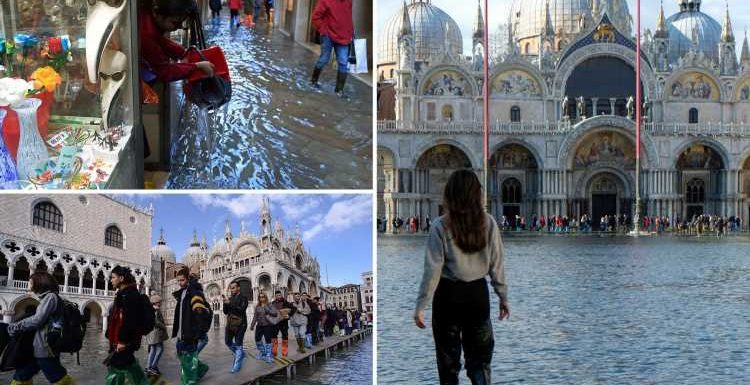
THE mayor of Venice says the “future of the city” hangs in the balance after "apocalyptic" floods devastated the iconic lagoon metropolis.
More questions have been asked about a multi-billion euro barrier project which has been delayed because of escalating costs and corruption scandals.
Last night, sewage-tainted rivers coursed down streets overnight as water levels surged 1.87m above normal, the highest since 1966, which drove thousands of Venetians out of the city forever.
And mayor Luigi Brugnaro fears this disaster could have a similar impact on the city’s population.
He said: “Venice is on its knees.
“We are not just calculating the damages, but of the very future of the city – because the population drain also is a result of this.”
He called for a state of emergency as schools closed and firefighters struggled to answer distress calls from trapped residents.
"The damage will run into hundreds of millions of euros," said Mr Brugnaro, who blamed climate change for the flood.
He called the flood "a wound that will leave indelible signs" in the Italian city, known for its picturesque canals.
Italian Prime Minister Giuseppe Conte visited Venice yesterday and said the government is taking charge after the state of emergency was declared while promising funding.
He said: "The situation is dramatic – the people are suffering."
A barrier project, known as Mose, at the mouth of the lagoon has been blighted by corruption, escalating costs and delays.
In 2014, Venice’s then mayor Giorgio Orsoni was arrested along with 35 others after millions of euros were siphoned from the ambitious development.
Mose is not due to start operation until 2021 and critics fear that, despite it’s incredible costs, it won’t be effective.
The latest flooding was made more extreme by the strong southern wind forcing water up the Adriatic into the Venice lagoon.
On the island of Pellestrina, which acts as a barrier between the lagoon and the Adriatic, a 78-year-old man was electrocuted while trying to use an electrical pump to remove water from his house.
The president of the Veneto region, Luca Zaia, said that 80 per cent of the city had been submerged, describing it as an "apocalyptic disaster".
Tourists trying to return to hotels via wooden walkways found that they had been swept away, forcing them to climb through windows.
Water buses were flung onto quaysides or sunk.
"It was as if a huge wave entered our basilica," Carlo Alberto Tesserin, head of the board responsible for St Mark's Basilica.
"The basilica flooded again last year and aged 20 years in a day, but this was much worse."
Why is Venice so prone to flooding?
Venice experiences a phenomenon ‘acqua alta’ or ‘high water’ due to exceptional tide peaks in the Adriatric Sea.
The tidal peaks reach their maximum level in the Venetian Lagoon, which runs around and through the city, causing flooding in the region.
The causes of the tidal peaks are down to a number of factors, including the movement and phase of the moon, wind strengths and direction as well as rain level and rising sea-levels.
Exceptionally high tides in Venice occurs once every four years, on average.
However minor flooding in the city happens around four times a year and usually within the winter months.
High water can sometimes last only for a few hours but it is dependent on which part of the island is hit by floodwaters.
The Patriarch of Venice, Francesco Moraglia, said that the damage to the 11th century landmark’s marble columns and gold leaf mosaics was irreparable.
As St Mark's Square, the lowest point in Venice, filled with a metre of water, one visitor was filmed swimming across the piazza amid floating dead rats.
Mr Brugnaro said that the future of the historic city was at stake as extreme weather accelerated the population fall that began after the 1966 flood.
Right now, Venice has a total of 53,000 residents today – which is now from a high in the last century of 150,000.
One British resident, Jane Da Mosto, who campaigns for tourism controls, said that she was determined to stay.
She said: "There has been wonderful solidarity among residents clearing up and housing people.
"It's moments like this you realise only a living population can look after this city."
Source: Read Full Article














